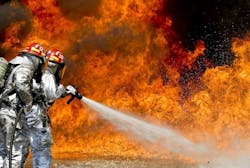Looking Back at the Cuyahoga River Fire 50 Years Later
The Cuyahoga River caught fire 20 years ago this week. The 1969 fire became a symbol of the U.S. environmental movement and led to the formation of the U.S. EPA and the enactment of the Clean Water Act, according to Chemical & Engineering News (C&EN).
The river has met recovery benchmarks but still is suffering from ecological problems, according to C&EN. In the late 1960s, the river was polluted and oozing with oil, chemicals and sludge. The river passed by steel mills, manufacturing plants, and a paint factory, taking in their discharge of waste, according to C&EN. President Richard M. Nixon formed EPA in 1970 and Congress passed the Clean Air Act the same year and the Clean Water Act in 1972.
Time magazine’s Aug. 1, 1969, issue made the river famous when the story on the incident included a photo from a prior fire on the Cuyahoga in 1952. The photo also included firefighters on a bridge spraying streams of water to a tugboat surrounded by flames, according to C&EN.
It was around this time that Mayor Carl Stokes recognized that it was not just a water issue but a social justice issue, according to WBUR.
"He got the city to pass a $100 million bond to start cleaning up the river at the same time the Time magazine article came out," said Jane Goodman executive director of the Cuyahoga River Restoration, according to WBUR. "There was this terrific photo of the 1952 fire and people bought it because it was a follow-up to the [Apollo 11] moon landing and on the cover was Teddy Kennedy in a neck brace. It was the Chappaquiddick issue. So the reason so many people found out about it was because they read that issue of Time magazine."
The river itself had caught fire 13 times by 1969, when it came to ahead. Goodman said that many at the time thought of the Cuyahoga as “an open sewer dump site.”
The area now has three wastewater treatment plants that were constructed in the early 20th century. Two plants release treated water into Lake Erie, and one discharges into Cuyahoga, according to C&EN.
Several changes have improved river conditions, including Clean Water Act. Many industries attached their discharge pipes into the public sewage system, subjecting their waste to treatment before discharge, according to C&EN.


